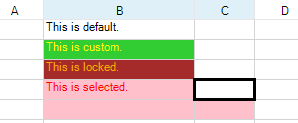-
Spread Windows Forms Product Documentation
- Getting Started
-
Developer's Guide
- Understanding the Product
- Working with the Component
- Spreadsheet Objects
- Ribbon Control
- Sheets
- Rows and Columns
- Headers
- Cells
- Cell Types
- Data Binding
-
Customizing the Sheet Appearance
- Customizing the Dimensions of the Component
- Customizing the Individual Sheet Appearance
- Customizing the Appearance of a Cell
- Customizing the Overall Component Appearance
- Creating and Applying a Style for Cells
- Using Conditional Formatting of Cells
- Customizing the Display of the Pointer
- Customizing the User Interface Images
- Using XP Themes with the Component
- Customizing the Renderers
- Handling Right-to-Left Layouts
- Customizing Painting of Parts of the Component
- Text Rendering with GDI
- Applying Theme to Customize the Appearance
- Customizing Interaction in Cells
- Tables
- Understanding the Underlying Models
- Customizing Row or Column Interaction
- Formulas in Cells
- Sparklines
- Keyboard Interaction
- Events from User Actions
- File Operations
- Storing Excel Summary and View
- Printing
- Chart Control
- Customizing Drawing
- Touch Support with the Component
- Spread Designer Guide
- Assembly Reference
- Import and Export Reference
- Version Comparison Reference
Coloring a Cell
You can set the background and foreground (text) colors for a cell or for a group of cells. An example of the different ways to set the colors for a cell is shown in the following figure. The code that created these cell colors is provided in the example.

You can specify the background color for a cell in code by using the BackColor property for that cell. You can specify the text color in code by using the ForeColor property.
You can also specify the colors to display when the cells are selected using SelectionBackColor and SelectionForeColor for the sheet. For more information on selections, refer to Customizing the Selection Appearance.
You can also specify a different color (for background or for text) in locked cells using the LockBackColor and LockForeColor properties of the SheetView or Appearance objects. For more information on locked cells, refer to Locking a Cell.
Using the Properties Window
At design time, in the Properties window, select the Spread component.
Select the Sheets property.
Click the button to display the SheetView Collection Editor.
In the Members list, select the sheet in which the cells appear.
In the properties list, select the Cells property and then click the button to display the Cell, Column, and Row Editor.
Select the cells for which you want to set the color.
In the properties list, select the BackColor property and select a color from the Custom, Web, or System tab. Select the ForeColor property and select that color.
Click OK to close the Cell, Column, and Row Editor.
Click OK to close the SheetView Collection Editor.
Using a Shortcut
Set the BackColor property or the ForeColor property for the Cells object.
Example
This example code sets the background color and text color for the second cell, sets the colors for locked cells, and sets the colors for selections.
fpSpread1.ActiveSheet.Cells[0,1].Value = "This is default.";
fpSpread1.ActiveSheet.Cells[1,1].Value = "This is custom.";
fpSpread1.ActiveSheet.Cells[2,1].Value = "This is locked.";
fpSpread1.ActiveSheet.Cells[3,1].Value = "This is selected.";
fpSpread1.ActiveSheet.Cells[1,1].BackColor = Color.LimeGreen;
fpSpread1.ActiveSheet.Cells[1,1].ForeColor = Color.Yellow;
fpSpread1.ActiveSheet.Cells[2,1].Locked = true;
fpSpread1.ActiveSheet.Protect = true;
fpSpread1.ActiveSheet.LockBackColor = Color.Brown;
fpSpread1.ActiveSheet.LockForeColor = Color.Orange;
fpSpread1.ActiveSheet.SelectionStyle = FarPoint.Win.Spread.SelectionStyles.SelectionColors;
fpSpread1.ActiveSheet.SelectionPolicy = FarPoint.Win.Spread.Model.SelectionPolicy.Range;
fpSpread1.ActiveSheet.SelectionUnit = FarPoint.Win.Spread.Model.SelectionUnit.Cell;
fpSpread1.ActiveSheet.SelectionBackColor = Color.Pink;
fpSpread1.ActiveSheet.SelectionForeColor = Color.Red;fpSpread1.ActiveSheet.Cells(0,1).Value = "This is default."
fpSpread1.ActiveSheet.Cells(1,1).Value = "This is custom."
fpSpread1.ActiveSheet.Cells(2,1).Value = "This is locked."
fpSpread1.ActiveSheet.Cells(3,1).Value = "This is selected."
fpSpread1.ActiveSheet.Cells(1,1).BackColor = Color.LimeGreen
fpSpread1.ActiveSheet.Cells(1,1).ForeColor = Color.Yellow
fpSpread1.ActiveSheet.Cells(2,1).Locked = True
fpSpread1.ActiveSheet.Protect = True
fpSpread1.ActiveSheet.LockBackColor = Color.Brown
fpSpread1.ActiveSheet.LockForeColor = Color.Orange
fpSpread1.ActiveSheet.SelectionStyle = FarPoint.Win.Spread.SelectionStyles.SelectionColors
fpSpread1.ActiveSheet.SelectionPolicy = FarPoint.Win.Spread.Model.SelectionPolicy.Range
fpSpread1.ActiveSheet.SelectionUnit = FarPoint.Win.Spread.Model.SelectionUnit.Cell
fpSpread1.ActiveSheet.SelectionBackColor = Color.Pink
fpSpread1.ActiveSheet.SelectionForeColor = Color.RedUsing Code
Set the BackColor property or the ForeColor property for a Cell object.
Example
This example code sets the background color for cell A1 to Azure and the foreground color to Navy, then sets the background color for cells C3 through D4 to Bisque.
FarPoint.Win.Spread.Cell cellA1;
cellA1 = fpSpread1.ActiveSheet.Cells[0, 0];
cellA1.BackColor = Color.Azure;
cellA1.ForeColor = Color.Navy;
FarPoint.Win.Spread.Cell cellrange;
cellrange = fpSpread1.ActiveSheet.Cells[2,2,3,3];
cellrange.BackColor = Color.Bisque;Dim cellA1 As FarPoint.Win.Spread.Cell
cellA1 = fpSpread1.ActiveSheet.Cells(0, 0)
cellA1.BackColor = Color.Azure
cellA1.ForeColor = Color.Navy
Dim cellrange As FarPoint.Win.Spread.Cell
cellrange = fpSpread1.ActiveSheet.Cells(2, 2, 3, 3)
cellrange.BackColor = Color.BisqueUsing the Spread Designer
In the work area, select the cell or cells for which you want to set the background color.
In the properties list (in the Misc category), select the BackColor property to set the background color.
Click the drop-down button to display the color picker and choose the color from the available colors.
To set the text color, repeat those steps and select ForeColor property in the properties list.
From the File menu choose Apply and Exit to apply your changes to the component and exit Spread Designer.
See Also
Setting the Background Colors for a Sheet


